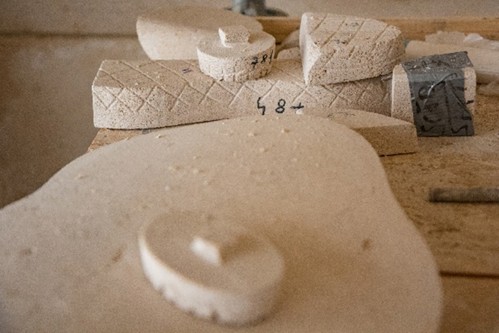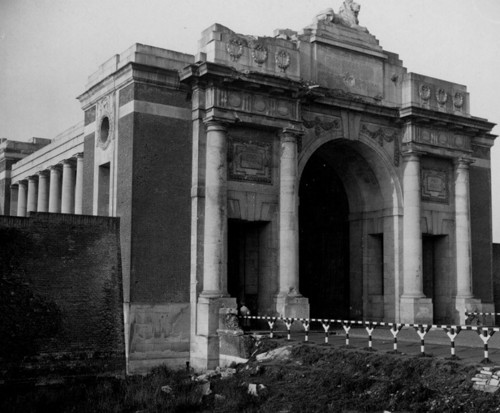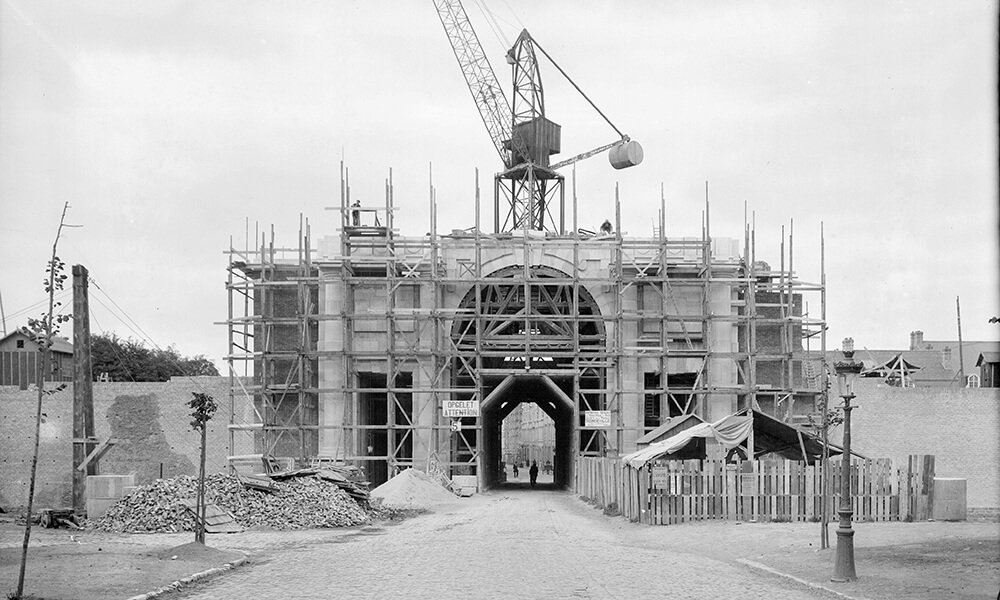09 September 2024
The Menin Gate in Numbers
How well do you know the Menin Gate and its restoration? Get insights into this most iconic of Commonwealth War Graves war memorials to the missing.
What is The Menin Gate? FACTS

Image: The magnificent Ypres (Menin Gate) Memorial
The Menin Gate is dedicated to the Commonwealth soldiers, excluding New Zealanders, who fought and died in the Ypres Salient, Belgium, but have no known grave.
Nearly 55,000 names of Commonwealth officers and enlisted men are inscribed on the Menin Gate memorial’s name panels.
- 54,577 servicemen commemorated
- 5 Commonwealth nations represented
- 40,500 UK casualties
- 6,935 Canadian casualties
- 6,179 Australian casualties
- 561 South African casualties
- 412 Indian casualties
- 60 name panels made from 1210 pieces of natural stone weighing 250kg
- 3 different types of natural stone
Restoring the Menin Gate

Image: The Ypres (Menin Gate) is currently undergoing a thorough restoration, featuring on stonework, sculpture and more
Since April 2023, we’ve been thoroughly restoring the Menin Gate to bring it back to the standards befitting such an iconic memorial.
For nearly 100 years, the Menin Gate has stood proudly over the Menin Road, one of the key routes into the Ieper city centre.
Over the years, it has picked up a few knocks and wear and tear, which is only natural for a building of this age and exposure.
So far, we have made over 500 repairs and restorations to the natural stone elements of the Menin Gate Memorial.
For much of the restoration, the memorial was hidden behind 260 tons of scaffolding, including 30 tons of wooden beams, so the workers could put their skills to good use sprucing it up.
Such was the size of the scaffolding, it took four weeks to remove! Why? Well, removing it while working at height, in public, trying to protect a near-100-year-old structure, was difficult,
The restoration is still ongoing. 30 workers a day are busy working away, including architects, stone masons, health and safety specialists, roofing teams, and masons. Together, their work is paying off beautifully.
Numbers & repairs
 Image: As much recycled natural stone as possible was used to restore the Menin Gate (Photo by Giovani Faghel for Monument Vandekerckhove)
Image: As much recycled natural stone as possible was used to restore the Menin Gate (Photo by Giovani Faghel for Monument Vandekerckhove)
The size and nature of this project means we’ve had to carefully document each step, including those all-important stonework refreshes.
Wherever a repair to the masonry or stonework has been made, it has been logged and numbered. This is so our craftsman can keep track of all their interventions and repairs for both present logging, and if they need to go back and review their work in the future.
In accordance with our sustainability practices and philosophy, as much recycled natural stone as possible was used for restoration. New stone was only used if absolutely necessary.
Did you know that the Menin Gate has both a basement and an attic?

Image: A panoramic view from the roof of the Menin Gate with vistas over Ypres (© Eric Compernolle)
Beneath each gallery is a large concrete basement, which acts as the Menin Gate’s foundations. Elsewhere, the space above the main atrium and the cassette wall is what we call the attic.
If you spotted one of the beautiful oak doors on each corner of the memorial, these are the portals that take our crews up to the roof. Each route featured a spiral staircase. These have been removed and sent to an ironsmith to bring them back to life.
Although the roof is not open to the public, access is needed for our maintenance teams – and to let poppy petals flutter through the roof’s three oculi every year for the Armistice ceremonies!
The three oculi are the three round openings in the Menin Gate’s roof. Look closely though, and you’ll notice they are not perfectly circular. They are elliptical instead! Each was thoroughly cleaned and inspected during the restoration.
One more secret of the memorial’s roof was discovered during the restoration process. A mechanical pulley system was found. It was used to manually lower candle chandeliers through the oculi to illuminate the Last Post Service which takes place every night at 08.00 pm.
Nowadays, we use the lighting installed in previous restorations and upgrades.
The Lions of the Menin Gate Memorial

Image: The Lions of the Menin Gate are also being restored to their true glory
Lion sculptures and motifs are prominently displayed on the memorial.
A large lion lays languidly across the Memorial’s roof for instance, while stone and bronze sculptures, statues, and friezes show more lions both rampart and repose.
No decoration is integrated into a CWGC memorial without a reason and it’s the same story of the Menin Gate and its big cats.
The lion has been the symbol of Ieper since the 14th century when it was incorporated into the personal coat of arms of Robert III, Duke of Flanders. From then on, the lion has been linked to Ypres, as well as the Flanders Flag.
You’ll notice different expressions carved lovingly into the various Menin Gate lion’s faces. Some are defiant; others bear intense sorrow and grief in response to the tens of thousands of young men losing their lives in and around Ypres during the World Wars.
Battle scars
 Image: The Menin Gate in the 1940s (© KIK-IRPA)
Image: The Menin Gate in the 1940s (© KIK-IRPA)
The Menin Gate is indelibly linked to the First World War but did you know it also has Second World War history too?
The memorial was opened in 1927 with ceremonies led by Field Marshal Herbert Plumer where he delivered the immortal lines “he is not missing, he is here!”, regarding the Menin Gate’s purpose as a place of permanent commemoration to the missing.
Every evening since then, at 08.00 pm, the Last Post ceremony has been played in a moving ceremony. The only period the Last Post Ceremony did not take place was during Ypres’ occupation in World War Two.
The city was fought over once more during the Battle of Ypres-Comines Canal but without the sheer volume of destruction visited on the city during the Great War.
The Menin Gate took a few bumps and scrapes as the war passed through Ieper in Belgium.
During the restoration, we decided to not repair the memorial’s Second World War battle scars unless their deterioration was too. The bullet marks and masonry hits are authentically and intrinsically connected to the Menin Gate’s history.
Discover more about the Menin Gate Restoration today

The restoration of the Menin Gate Memorial began in 2023 and is now completed, preserving it for decades to come. Discover more about this remarkable process today.
Read more about the Menin Gate Memorial Restoration
